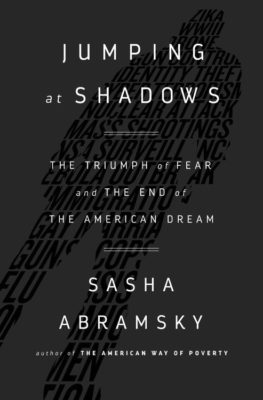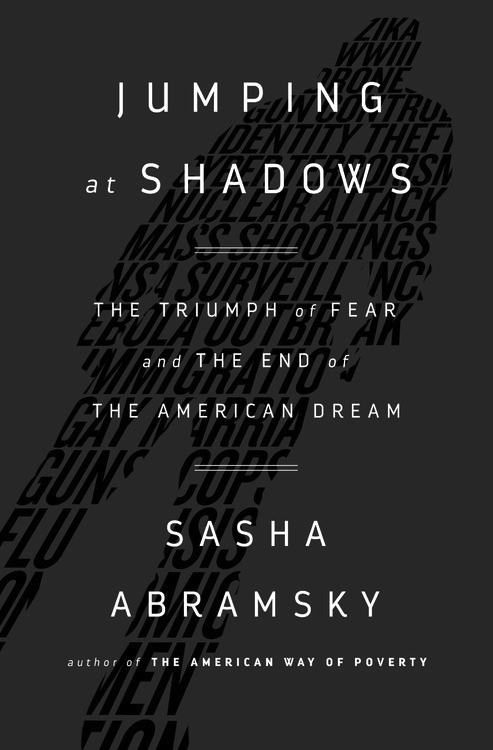Reggie Watts’ 2012 TED Talk had many unique observations, but one has always stuck with me as particularly insightful. In his words: “As we face fear in these times — and fear is all around us — we also have anti-fear.”

That line of satirical pseudo-babble was part of an improvised comedy/musical performance but has achieved a surprising resonance in years since, and it’s as concise a summary of journalist Sasha Abramsky’s latest book Jumping At Shadows as the one provided by the book’s publisher:
In this day and age, perhaps the thing that binds Americans together most strongly is the fact that we’re afraid.
But are we afraid of the right things?
Abramsky makes a convincing case that we’re clearly not worried enough about what’s actually commonly dangerous and preventable compared with things that are rare, unavoidable, or outright false.
A prominent example he gives is the widespread panic in response to the U.S. portion of an ebola outbreak that killed one person and infected a total of four back in 2014. This outbreak received a huge amount of media coverage and generated a lot of anxiety. But while relatively few people died from that ebola outbreak, 12,000 to 56,000 Americans have died from seasonal influenza every year since 2010.
If this phenomenon is interesting to you, you should consider picking up this book.
Each topic is supported with data and sound reasoning; each is important to the health and welfare of the nation going forward. But that also means the topics are so important, you’re sure to have heard about them before, including the precise examples Abramsky looks at, from Doomsday Preppers to the Texas boy who made a clock authorities assumed to be a bomb because he was a Muslim.
“I believe that too often we calculate risk not by the probability of an event occurring but by the number of news items or talk radio minutes or Facebook postings or movie screens devoted to a topic,” the author writes.
Our inherited rodent brain does tend to make us literally “jump at shadows”, and we’re neurologically primed to skitter at possible warnings like cats noticing vaguely serpentine cucumbers. (You know airplanes are safer than driving, but your heart still races during turbulence more than pulling through an intersection.)
Knowledge and change based on knowledge are very far apart.
Abramsky admits as much while interviewing parents who agree, intellectually, that American society is actually safer for children now than thirty years ago, that firearms in the home are more likely to be used against someone in the household than defending it from any strangers.
But those parents still cling to ever-more guns and still fear their children walking alone, even to gated schools, even if wearing bulletproof backpacks.
The book promises “a playbook for how to conquer…the most frightening aspects of modern life,” but if you’re feeling irrational fears, that playbook sounds like something out of a Bob Newhart sketch on “Saturday Night Live”: Just stop it.
If that’s the best advice possible, it’s the same one that Abramsky criticizes regarding Doomsday Preppers — a non-programmatic, non-policy suggestion.
Other than feeling a sense of superiority over bigots, guns nuts, anti-vaxxers, and the like, what good does the reader get out of any of it?
And that’s all taking Abramsky’s argument at face-value.
It gets worse if you start to interrogate it.
The subtitle of this book is The Triumph of Fear and the End of the American Dream. Abramsky is arguing fear, pushed by current technology, is what makes individuals afraid of Muslim, immigrant, and black Americans, and what got Donald Trump elected as president by the Electoral College in 2016.
Though Trump won in the Electoral College, it must be noted that the Democratic nominee, Hillary Clinton, won the national popular vote.
This is a much better result than we’ve had previous times in our history that people pronounced the American Dream dead; Hunter S. Thompson had more reason to fear and loathe in ’72, considering that election’s margins. Did nativism, religious intolerance, and racism motivate us less in the past than now?
There’s one more flaw in the book that hurts it, and that’s a structural one.
The introduction tells the story of a trip the author took to South America, where he was poisoned by ciguatoxin, apparently from bad fish in Chile.
The symptoms he experienced were similar to a heart attack but impossible to definitively diagnose. The poisoning sapped his physical strength but also his confidence, his willingness to take risks, everything, and all of it irrationally.
Abramsky makes the connection from his body to the body politic in the book’s introduction, but doesn’t circle back to make the connection later in the book. Which is a shame because the obvious lesson from his personal anecdote is also seemingly the solution the problems the book is describing.
You don’t push aside your fear of flying purely because of statistics, but because some places you can’t get to quickly enough, or at all, except by plane.
You travel, you try new food, you let your children play and explore, because life is hardly worth living otherwise.
Every attempt at eliminating risk also involves eliminating value. We have to live our lives balancing these things against each other, counter-stacking worries to achieve healthy equilibrium. That’s a worthwhile and effective message to combat fear-mongering. Because fear is all around us. But there is also anti-fear.

